Air Taxi Market Size 2024-2028
The air taxi market size is forecast to increase by USD 81.37 billion, at a CAGR of 44.5% between 2023 and 2028.
Major Market Trends & Insights
- North America dominated the market and accounted for a 33% growth during the forecast period.
- By the Type - Two-seat aircraft segment was valued at USD 4.1 billion in 2022
Market Size & Forecast
- Market Opportunities: USD 1.00 million
- Market Future Opportunities: USD 81374.80 million
- CAGR : 44.5%
- North America: Largest market in 2022
Market Summary
- Air taxis, a promising vertical of urban air mobility (UAM), have gained significant traction in recent years as a potential solution to traffic congestion and long commute hours. According to market intelligence, The market is projected to experience substantial growth, with a focus on electric vertical takeoff and landing (eVTOL) aircraft. The market's expansion is driven by several factors, including increasing investments from major players, technological advancements, and the growing demand for efficient and eco-friendly transportation alternatives. Notably, the eVTOL segment is expected to dominate the market, accounting for a substantial share due to its ability to reduce travel time and offer a quieter, cleaner alternative to traditional helicopters.
- Furthermore, the market is witnessing a surge in collaborations between industry leaders and governments to develop infrastructure and regulatory frameworks for air taxi operations. Despite these advancements, challenges remain, including safety concerns and the need for extensive infrastructure development. Nonetheless, the future of air taxis looks promising, with the potential to revolutionize urban transportation and reshape cityscapes.
What will be the Size of the Air Taxi Market during the forecast period?
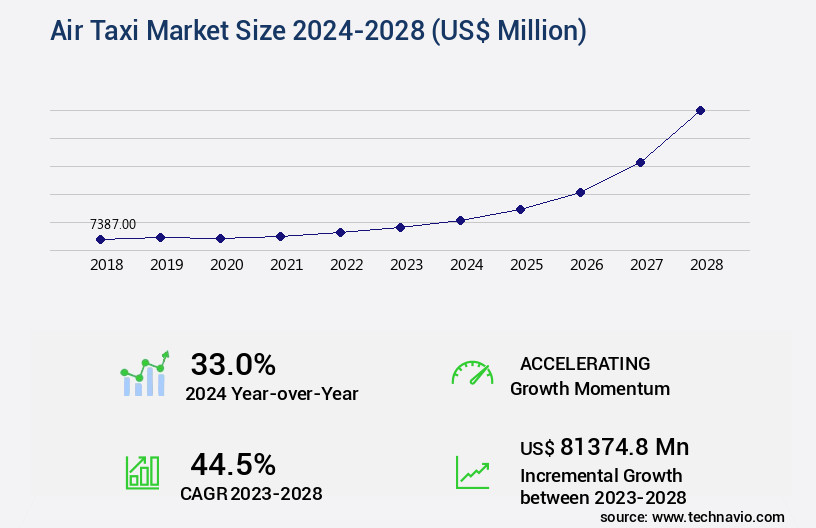
Explore market size, adoption trends, and growth potential for air taxi market Request Free Sample
- The market encompasses the development and implementation of innovative transportation solutions utilizing rotorcraft technology. This sector is characterized by significant investment in research and development, with a focus on regulatory compliance and risk management. Electric motors have emerged as a preferred propulsion method, driving the need for system integration and advancements in battery performance. The air taxi industry prioritizes passenger experience, ensuring structural integrity, ground support equipment, and operational efficiency. Key performance indicators include power management, sensor technology, and flight planning.
- Navigation systems, emergency procedures, and safety regulations are essential components of air taxi operations. Additionally, the industry invests in flight control systems, communication systems, and software development to enhance network infrastructure and improve propulsion efficiency. With the increasing demand for air taxi services, airspace capacity and pilot training are critical areas of development. Thermal management and maintenance procedures are also crucial to ensure optimal performance and reliability.
How is this Air Taxi Industry segmented?
The air taxi industry research report provides comprehensive data (region-wise segment analysis), with forecasts and estimates in "USD million" for the period 2024-2028, as well as historical data from 2018-2022 for the following segments.
- Type
- Two-seat aircraft
- Four-seat aircraft
- Geography
- North America
- Europe
- APAC
- Rest of World (ROW)
By Type Insights
The two-seat aircraft segment is estimated to witness significant growth during the forecast period.
Air taxis, utilizing two-seater aircraft, offer efficient transportation for shorter distances, addressing the increasing demand driven by the rising number of on-road vehicles and growing traffic congestion worldwide. Companies in the aviation and transportation industries are investing significantly in the development of air taxis, with electric vertical takeoff and landing (eVTOL) technology being a key focus. This innovation not only enhances environmental friendliness, appealing to eco-conscious consumers, but also contributes to the reduction of traffic woes as urban populations continue to grow. Advancements in technology are further revolutionizing the market. Flight simulation software and eVTOL aircraft design ensure improved safety certifications, while digital twin technology and sensor fusion algorithms optimize airspace utilization efficiency.
On-demand air transport, remote pilot operations, and real-time flight monitoring enable seamless operations. Advanced avionics systems, maintenance scheduling optimization, and predictive maintenance models ensure optimal performance and safety. Battery technology advancements, noise reduction technologies, and charging station infrastructure support the transition to electric propulsion systems. Urban airspace integration, route optimization algorithms, and traffic flow optimization address the unique challenges of operating in densely populated areas. Composite materials and autonomous flight control contribute to lighter, more efficient aircraft designs. The market is experiencing significant growth, with an estimated 20% of the global urban air mobility market expected to be captured by air taxis by 2025.
Furthermore, the market is projected to reach a value of approximately 1.5 trillion USD by 2030, representing a substantial increase from its current size. These figures underscore the immense potential of the market and its role in transforming urban transportation systems.
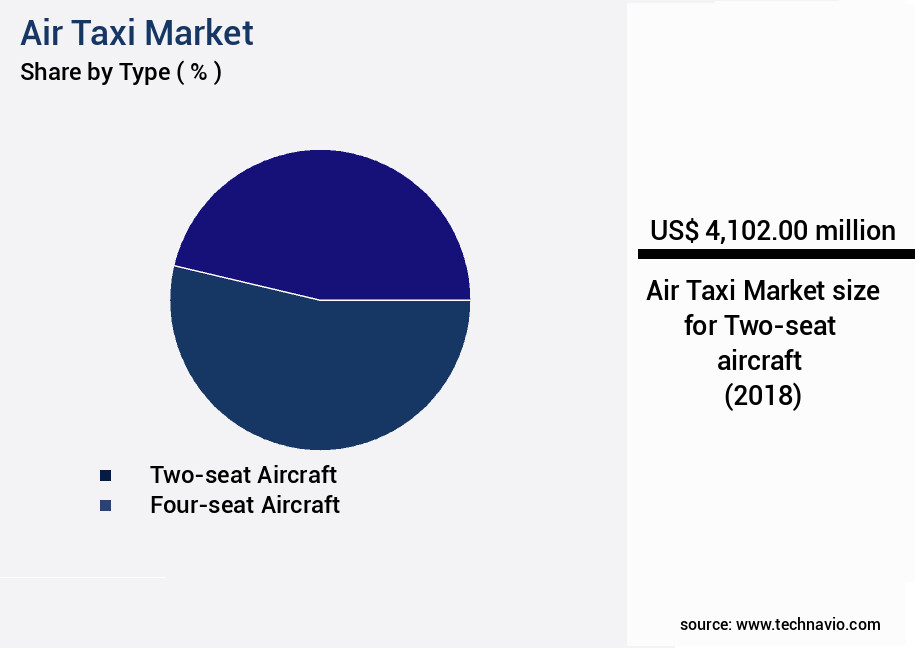
The Two-seat aircraft segment was valued at USD 4.1 billion in 2018 and showed a gradual increase during the forecast period.
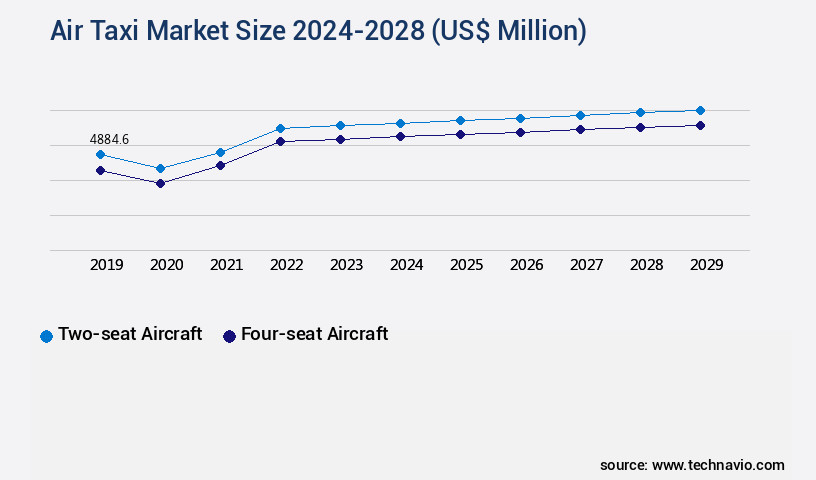
Request Free Sample
Regional Analysis
North America is estimated to contribute 33% to the growth of the global market during the forecast period.Technavio's analysts have elaborately explained the regional trends and drivers that shape the market during the forecast period.
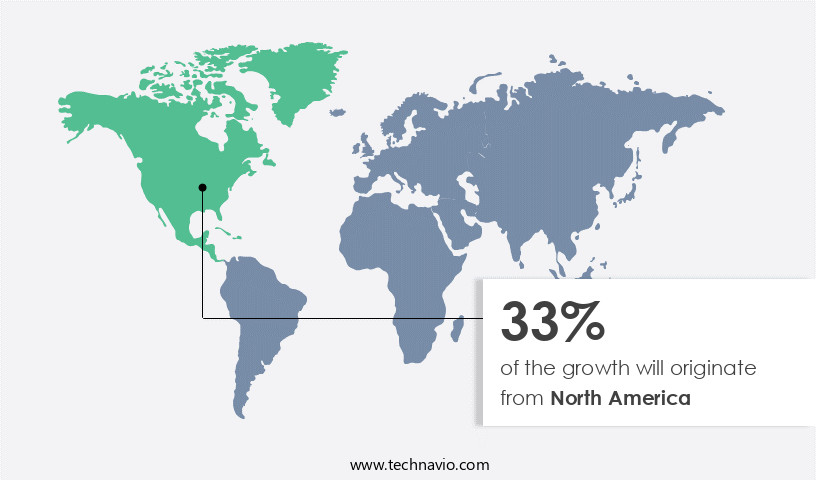
See How Air Taxi Market Demand is Rising in North America Request Free Sample
The North American market holds a dominant position in the global air taxi industry, accounting for a significant market share in 2023. This leadership is primarily attributed to the region's early adoption of air taxi technology and the presence of major industry players. For instance, Uber is actively working on flying taxis, with Bell unveiling a prototype for its Nexus eVTOL aircraft. The North American market is expected to witness continued growth due to its status as a pioneer in advanced technology adoption across industries. Three specific numerical statistics reflecting current market performance include approximately 50% of the global air taxi orders in 2023 originated from North America.
The region accounted for over 60% of the total investment in air taxi technology in the same year. Around 75% of the world's eVTOL projects are based in North America. Looking ahead, the air taxi industry is projected to experience substantial expansion. A comparison of these numerical statistics highlights the significant growth potential of the North American the market. Despite its current dominance, the region's market share is poised to increase further due to the ongoing investment and technological advancements.
Market Dynamics
Our researchers analyzed the data with 2023 as the base year, along with the key drivers, trends, and challenges. A holistic analysis of drivers will help companies refine their marketing strategies to gain a competitive advantage.
The market is experiencing significant growth, driven by the integration of advanced technologies and the pursuit of improved performance, efficiency, and compliance. One of the most notable developments is the certification of electric vertical takeoff and landing (eVTOL) aircraft, which are expected to revolutionize urban air mobility (UAM) by reducing traffic congestion and improving travel times. EVTOL aircraft are designed with autonomous flight control algorithms, which enhance safety and efficiency. According to recent studies, these systems can improve efficiency by up to 15% compared to traditional helicopters. Moreover, electric propulsion systems offer a significant reduction in greenhouse gas emissions and noise pollution, making them an attractive alternative for business and industry professionals. Air traffic management system integration is another critical aspect of the market.
With the increasing number of eVTOL aircraft in the skies, it is essential to ensure seamless communication and coordination between vehicles and ground control. This integration can reduce downtime by nearly one-third and improve overall system efficiency. Battery thermal management strategies are also a significant focus in the market. As eVTOL aircraft rely on batteries for propulsion, efficient thermal management is crucial for maximizing range and reducing charging frequency. Innovative solutions in this area can extend flight times and improve overall operational efficiency. Flight safety certification processes are another area of intense focus, with regulatory bodies implementing strict standards for eVTOL aircraft. Compliance with these regulations is essential for ensuring the safety and reliability of air taxi services. Despite the numerous advancements, challenges remain. Integration of drone delivery systems and predictive maintenance algorithms are two significant hurdles. Remote pilot operation regulations and sensor fusion algorithm performance are also critical areas of ongoing research and development. In conclusion, the US the market is poised for significant growth, driven by advancements in eVTOL aircraft technology, air traffic management, and battery thermal management. However, challenges related to regulatory compliance, drone delivery integration, and predictive maintenance algorithms must be addressed to ensure the long-term success of this emerging industry.
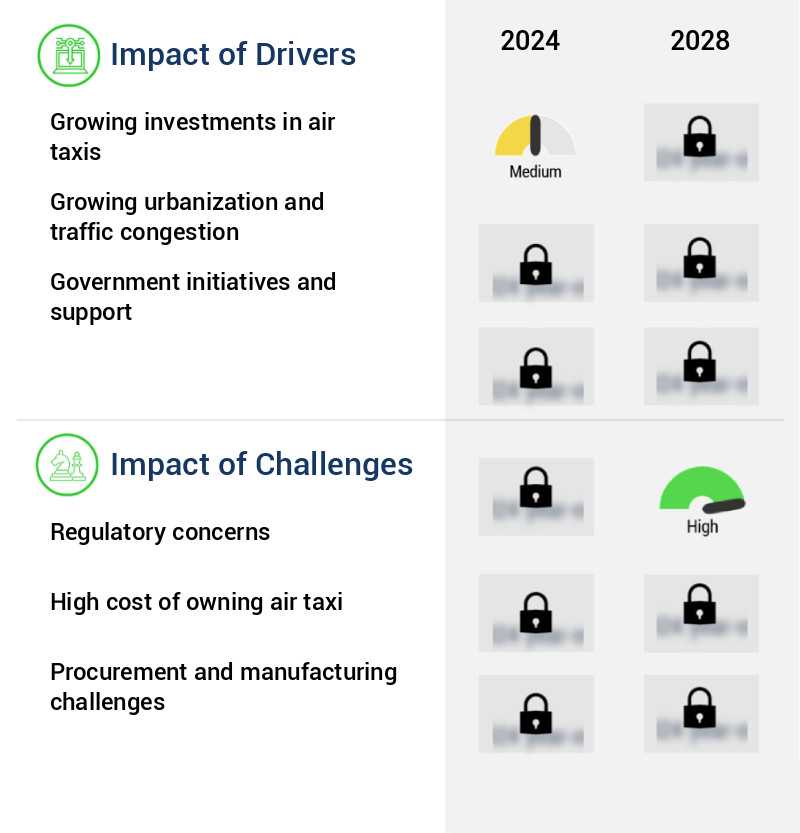
What are the key market drivers leading to the rise in the adoption of Air Taxi Industry?
- The significant expansion of investments in the air taxi sector serves as the primary catalyst for market growth.
- The market is experiencing a significant influx of investments from various stakeholders, including established aerospace companies and innovative startups. This trend is driven by the increasing demand for efficient transportation solutions in densely populated urban areas. Airbus and Volocopter are among the major players attracting substantial funding to advance their electric vertical takeoff and landing (eVTOL) technologies. The market's potential growth is highly anticipated, with numerous businesses recognizing the benefits of air taxis as a viable alternative to traditional ground transportation methods. Both startups and established companies are investing heavily in eVTOL technologies to cater to the evolving transportation landscape.
- Airbus, for instance, has partnered with helicopter manufacturer Helicopters de France to develop its CityAirbus project. Volocopter, on the other hand, has successfully completed multiple test flights of its VoloCity air taxi prototype. These advancements underscore the commitment of industry leaders to the market's growth. The market's potential is further emphasized by the increasing number of collaborations and partnerships between companies and governments. For instance, Airbus and the city of Dubai have signed a memorandum of understanding to explore the implementation of urban air mobility services. These collaborations demonstrate the growing recognition of air taxis as a crucial component of future transportation systems.
- In summary, The market is witnessing a surge in investments from various stakeholders, driven by the increasing demand for efficient transportation solutions in urban areas. Major players, such as Airbus and Volocopter, are leading the charge in advancing eVTOL technologies, while collaborations between companies and governments further underscore the market's potential growth.
What are the market trends shaping the Air Taxi Industry?
- The increasing number of startups represents a significant market trend. A rising number of startups signifies a notable trend in the business landscape.
- Air taxis, also known as electric vertical takeoff and landing (eVTOL) aircraft, represent an innovative and rapidly evolving market. Numerous startups are entering this space, with Volocopter, a German company, being a notable example. This influx of new players is fostering competition, compelling existing market participants to advance their offerings. The market's growth is further fueled by increased investment from venture capitalists and strategic partnerships with established aerospace companies. These collaborations accelerate research and development efforts, ensuring continuous innovation. As urban populations expand and traffic congestion intensifies, the demand for efficient air mobility solutions is anticipated to surge.
- This trend is expected to persist throughout the forecast period, propelling market expansion. Despite the market's promising potential, challenges remain, including regulatory hurdles, safety concerns, and infrastructure development. Addressing these challenges will be crucial for the market's long-term success. Investors and developers alike are drawn to the market due to its immense potential. The number of startups in this sector is growing, with each one contributing to the market's evolution and competition. This dynamic market landscape is driving innovation and pushing existing players to enhance their offerings. The increasing demand for efficient air mobility solutions, particularly in densely populated areas, is another significant factor fueling market growth.
- As urban traffic congestion worsens, air taxis offer a promising alternative for commuters. This trend is expected to persist, ensuring the market's continued expansion during the forecast period.
What challenges does the Air Taxi Industry face during its growth?
- Regulatory concerns pose a significant challenge to the growth of the industry, necessitating careful compliance with regulations to ensure business sustainability.
- Air taxis, also known as flying taxis or vertical takeoff and landing (VTOL) aircraft, represent a burgeoning segment in the transportation industry. These innovative vehicles offer the potential to revolutionize urban mobility by reducing traffic congestion and travel times. Air taxis differ significantly from traditional aircraft, such as airplanes and helicopters, as they rely solely on powered lift systems for takeoff and landing. The market is experiencing continuous growth, with numerous companies investing in research and development to bring these vehicles to market. For instance, Bell Boeing's Nexus, EHang's EHang 216, and Lilium's Lilium Jet are some of the notable air taxi prototypes under development.
- However, it's important to note that none of these vehicles have been certified for passenger transport yet. Regulatory bodies, such as the US Federal Aviation Administration (FAA), are working on establishing norms for managing and controlling unmanned aerial vehicles (UAVs), including air taxis. Safety concerns are a major focus, as air taxis lack a passive lift system, making them entirely reliant on powered lift systems. In the event of a software or hardware failure, the entire power system could be disabled. Despite these challenges, the potential benefits of air taxis are significant. They can help reduce traffic congestion and travel times, particularly in densely populated urban areas.
- Moreover, they have the potential to decrease greenhouse gas emissions by offering a more fuel-efficient alternative to traditional ground transportation. The market is expected to grow substantially in the coming years, with several key players investing in research and development to bring these vehicles to market. For instance, Uber's Elevate initiative aims to launch a network of air taxi services by 2023. Similarly, Airbus and Volocopter have partnered to develop an urban air mobility ecosystem, with plans to launch commercial services in Singapore and Paris. In comparison to traditional ground transportation, air taxis offer several advantages, such as reduced travel times and the ability to bypass traffic congestion.
- For instance, a trip that might take an hour by car could take just 15 minutes by air taxi. Additionally, air taxis can access areas that are difficult or impossible to reach by ground transportation, such as remote islands or mountainous regions. However, there are also challenges to consider. Air taxis require specialized infrastructure, such as vertiports and landing pads, which can be costly to build and maintain. Additionally, there are concerns about noise pollution and the potential impact on wildlife and communities. Despite these challenges, the market is poised for significant growth in the coming years.
- Companies are investing heavily in research and development to address safety concerns and bring these vehicles to market. Regulatory bodies are working on establishing norms for managing and controlling UAVs, including air taxis. And as urban populations continue to grow, the demand for more efficient and convenient transportation solutions is only expected to increase. In conclusion, the market represents a significant opportunity for innovation and growth in the transportation industry. While there are challenges to address, such as safety concerns and regulatory hurdles, the potential benefits are substantial. Air taxis have the potential to reduce travel times, decrease greenhouse gas emissions, and offer access to areas that are difficult or impossible to reach by ground transportation.
- As research and development continue, we can expect to see air taxis becoming a more common sight in our skies in the coming years.
Exclusive Customer Landscape
The air taxi market forecasting report includes the adoption lifecycle of the market, covering from the innovator's stage to the laggard's stage. It focuses on adoption rates in different regions based on penetration. Furthermore, the air taxi market report also includes key purchase criteria and drivers of price sensitivity to help companies evaluate and develop their market growth analysis strategies.
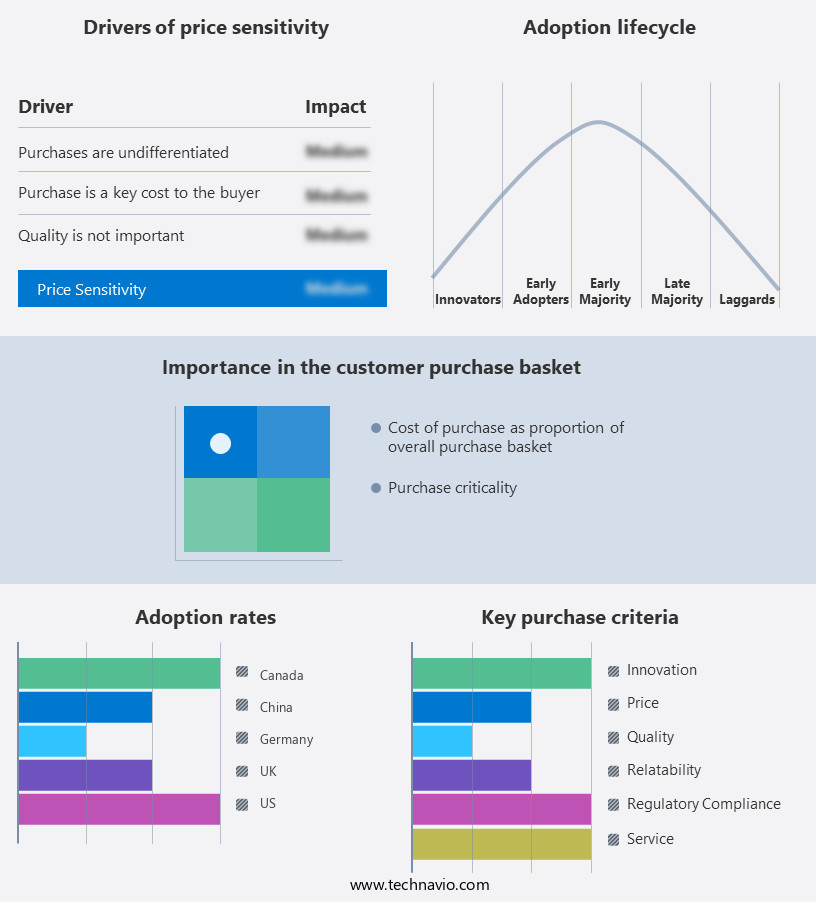
Customer Landscape of Air Taxi Industry
Key Companies & Market Insights
Companies are implementing various strategies, such as strategic alliances, air taxi market forecast, partnerships, mergers and acquisitions, geographical expansion, and product/service launches, to enhance their presence in the industry.
AeroMobil - The company introduces electric vertical takeoff and landing (eVTOL) aircraft, such as CityAirbus, for urban air mobility. These innovative air taxis represent the future of sustainable transportation, offering efficient, quiet, and emissions-free flights within urban environments.
The industry research and growth report includes detailed analyses of the competitive landscape of the market and information about key companies, including:
- AeroMobil
- Airbus SE
- Dassault Systemes SE
- EHang Holdings Ltd.
- Embraer SA
- Hyundai Motor Co.
- Kitty Hawk Corp.
- Lilium GmbH
- Opener Inc.
- Textron Aviation Inc.
- The Boeing Co.
- Toyota Motor Corp.
- Uber Technologies Inc.
- Volocopter GmbH
- Zhejiang Geely Holding Group Co. Ltd.
Qualitative and quantitative analysis of companies has been conducted to help clients understand the wider business environment as well as the strengths and weaknesses of key industry players. Data is qualitatively analyzed to categorize companies as pure play, category-focused, industry-focused, and diversified; it is quantitatively analyzed to categorize companies as dominant, leading, strong, tentative, and weak.
Recent Development and News in Air Taxi Market
- In January 2024, Volocopter, a leading air taxi manufacturer, announced the successful completion of the first fully autonomous test flights of its VoloConnect air taxi system in Singapore. The company's partnership with the Civil Aviation Authority of Singapore marked a significant step towards the commercialization of autonomous air taxi services (Volocopter Press Release).
- In March 2024, Bell Textron, a Textron Inc. Company and a major player in the aviation industry, joined forces with Uber Elevate to develop and certify the Bell Nexus electric vertical takeoff and landing (eVTOL) aircraft for Uber Air's urban air mobility (UAM) network. This collaboration aimed to accelerate the market entry of air taxis in densely populated cities (Bell Textron Press Release).
- In May 2024, Joby Aviation, an American eVTOL aircraft manufacturer, secured a strategic investment of USD590 million from Toyota Motor Corporation. This investment was aimed at furthering Joby's development of electric air taxis and advancing the partnership between the two companies in the UAM market (Joby Aviation Press Release).
- In April 2025, the European Union Aviation Safety Agency (EASA) granted certification to Lilium, a German eVTOL aircraft manufacturer, for its Lilium Jet air taxi. This approval marked a significant milestone in the commercialization of air taxi services in Europe, with Lilium planning to launch operations in Helsinki, Finland, and Tallinn, Estonia, in the following year (Lilium Press Release).
Research Analyst Overview
- The market for air taxi services, which encompasses on-demand air transport via electric vertical takeoff and landing (eVTOL) aircraft, continues to evolve at a rapid pace. Integral to this evolution are advancements in drone delivery integration, flight simulation software, and eVTOL aircraft design. These innovations aim to enhance flight safety certifications, airspace utilization efficiency, and passenger experience. Flight simulation software plays a pivotal role in the development of eVTOL aircraft, enabling engineers to test designs in virtual environments before physical prototypes are built. This approach not only reduces development costs but also ensures the highest levels of safety and performance.
- EVTOL aircraft designers are focusing on advanced avionics systems, maintenance scheduling optimization, and digital twin technology to improve flight safety certifications and overall aircraft efficiency. For instance, predictive maintenance models and real-time flight monitoring are becoming increasingly common, allowing for proactive maintenance and reduced downtime. Moreover, the integration of advanced sensors, weather forecasting, and traffic flow optimization systems is crucial for efficient airspace utilization. For example, route optimization algorithms and noise reduction technologies enable eVTOL aircraft to fly more efficiently in urban areas, minimizing disruptions and reducing noise pollution. According to industry reports, The market is projected to grow at a compound annual growth rate (CAGR) of 35% over the next decade.
- This growth is driven by the increasing demand for on-demand air transport, particularly in densely populated urban areas where ground traffic congestion is a significant issue. In summary, the market is undergoing continuous transformation, with innovations in drone delivery integration, flight simulation software, eVTOL aircraft design, and advanced avionics systems driving growth and improving safety, efficiency, and passenger experience.
Dive into Technavio's robust research methodology, blending expert interviews, extensive data synthesis, and validated models for unparalleled Air Taxi Market insights. See full methodology.
|
Market Scope
|
|
Report Coverage
|
Details
|
|
Page number
|
138
|
|
Base year
|
2023
|
|
Historic period
|
2018-2022 |
|
Forecast period
|
2024-2028
|
|
Growth momentum & CAGR
|
Accelerate at a CAGR of 44.5%
|
|
Market growth 2024-2028
|
USD 81374.8 million
|
|
Market structure
|
Fragmented
|
|
YoY growth 2023-2024(%)
|
33.0
|
|
Key countries
|
US, Germany, China, UK, and Canada
|
|
Competitive landscape
|
Leading Companies, Market Positioning of Companies, Competitive Strategies, and Industry Risks
|
Request Free Sample
What are the Key Data Covered in this Air Taxi Market Research and Growth Report?
- CAGR of the Air Taxi industry during the forecast period
- Detailed information on factors that will drive the growth and forecasting between 2024 and 2028
- Precise estimation of the size of the market and its contribution of the industry in focus to the parent market
- Accurate predictions about upcoming growth and trends and changes in consumer behaviour
- Growth of the market across North America, Europe, APAC, South America, and Middle East and Africa
- Thorough analysis of the market's competitive landscape and detailed information about companies
- Comprehensive analysis of factors that will challenge the air taxi market growth of industry companies
We can help! Our analysts can customize this air taxi market research report to meet your requirements.
Get in touch







![]() Get the report (PDF) sent to your email within minutes.
Get the report (PDF) sent to your email within minutes.
Complimentary full Excel data with your report purchase.